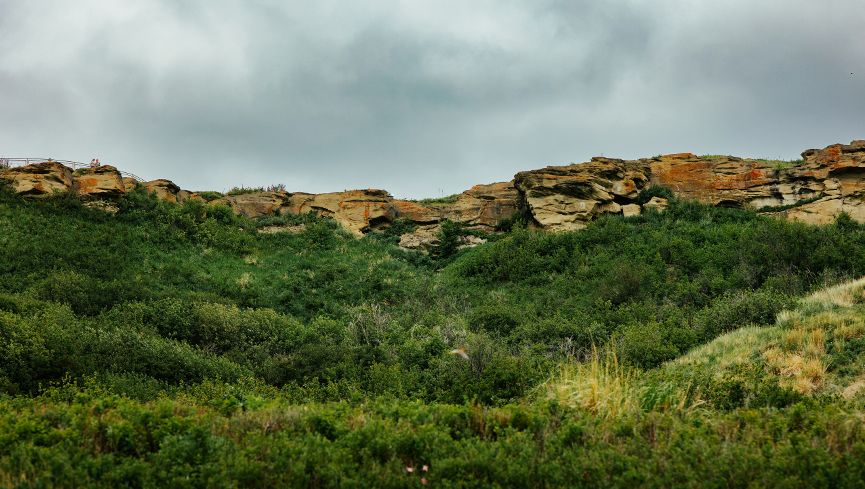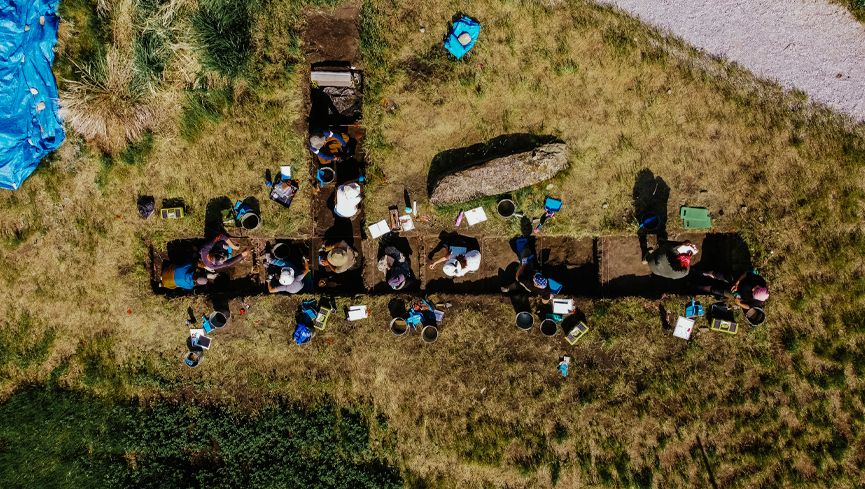For archaeology students, getting their hands dirty is a highlight of their education. This past summer, archaeology undergraduate and graduate students had the chance to get grit under their fingernails during the University of Lethbridge - Royal Alberta Museum field school at Head-Smashed-In Buffalo Jump. Under the supervision of Drs. Shawn Bubel (BSc ’96), Kevin McGeough (BA ’96) and Bob Dawe (Royal Alberta Museum), students worked directly with Blackfoot interpreters at the Head-Smashed-In Buffalo Jump Interpretive Centre, who are also collaborators on the project.
Their first step in attending the field school was a two-week long pre-class where they learned about working at a special place like Head-Smashed-In, which is both a UNESCO World Heritage and a Blackfoot site. The students also learned about the history of the site, the archaeology practiced in the region and Indigenous modes of knowing. Students read Indigenous authors and spoke to Elders and others to give them background about the site.
The students then made their way to the camp where they set up tents — their home away from home for the next four to five weeks. Head-Smashed-In is located at the edge of the Porcupine Hills in southwestern Alberta and is one of the most dramatic of the many sites that Indigenous people used as buffalo jumps.

This past summer, the students worked in two excavation areas. One, called the Processing Area, was a location that had previously been excavated by the Royal Alberta Museum in the 1980s. The other, called the Spring Channel, was where people would have camped and used the water to butcher and process the bison.
Students dug through compact silt and worked their way to earlier deposits. They found the base of a projectile point that dates to between 7,500 and 6,500 years ago and another that dates to 8,500 years ago.
“Then we found the base of an Alberta spearpoint that dates between 9,000 and 9,500 years ago,” says Bubel. “Now we are able to confirm that people were using this area of the site at least 9,000 to 9,500 years ago.”

Not only have the students made discoveries that reveal Indigenous peoples used the site much earlier than previously known, they are learning valuable skills that will serve them well in the future.
“On site, the students learn practical skills involved in archaeology like mapping, digging, how to use the tools and make sense of what they are finding,” says McGeough. “After the dig, the students learn about processing the artifacts, publishing them and analyzing and interpreting the cultural remains. This has prepared students really well for different kinds of work after the field school.”

In fact, the skills the students learned in last year’s field school are in such demand in the field of archaeology that students who participated in the 2021 field school were snatched up by industry and were already working as professional archaeologists when the second season started.
“These students are unlocking a period of the jump’s history that not much is known about, making an important contribution to understanding Alberta’s past and First Nations history,” says McGeough.
Students who participated in the field school include Eloise Amos, Keanna Barron, Kenya Bean, Joel Dick, Nathan Lockwood, Lily MacIntyre, Dallas Reay, Matthew Sawchuk, Ryland Schinbein, Ali Seyed Norani, Lauren Spear, and Victoria Rios.
- Paid work terms
- Hands-on career & research experience
- International study
- Awards, scholarships and a range of student support
Learn how!